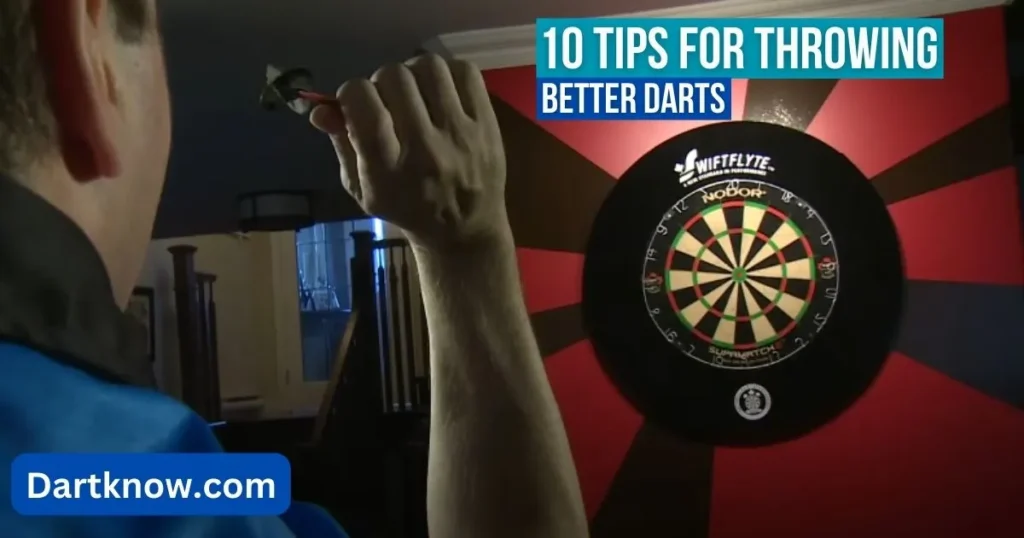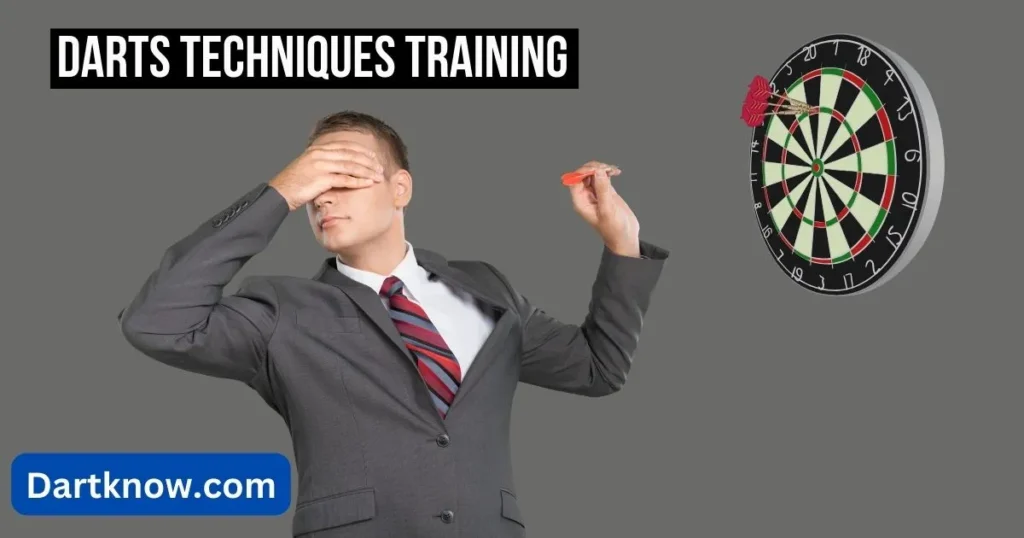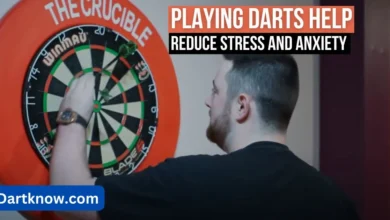How to Throw Darts with Precision: A Detailed Guide

Dart throwing is an enjoyable activity and a skill you may develop. Throwing darts with precision improves your score and increases your winnings. Consistent practice and focus help sharpen your aim over time. This guide will teach simple techniques to improve your dart-throwing skills.
It will explain why having a routine is essential for success. You will learn how to avoid common mistakes during gameplay. Tips on how to stay focused and eliminate distractions will be included.
Practicing with others will also be explained to help boost your confidence. These tips will help you improve your darts skills quickly. This guide is ideal for those who want to enhance their darts skills.
Why Precision Matters in Dart Throwing
In darts, accuracy is essential because even a minor mistake can lose you points. Winning games, tight competition, and high scoring depend on accurate dart throws. If it might be difficult for beginners to control their precision, the correct methods can significantly impact them.
Developing precise dart-throwing skills will increase your enjoyment of the game, control, and score. Accurate throws are essential when you’re going for a triple-20 or the bullseye.
10 Tips for Throwing Better Darts

Great dart throwing starts with understanding the basics and practicing regularly. Here are ten tried-and-true dart precision tips to up your game.
1. Focus on Your Stance
Stand with your dominant foot slightly forward, maintaining a stable and comfortable balance. Your stance plays a massive role in maintaining control and accuracy.
2. Grip the Dart Properly
Avoid gripping the dart too tightly or too loosely. A secure, relaxed grip allows for better control and a smooth release.
3. Position Your Arm Correctly
Keep your throwing arm at a 90-degree angle, with your elbow steady and aligned. Ensure your arm motion is smooth and controlled.
4. Find the Right Weight of Darts
Light darts offer a faster throw, while heavier darts feel more stable in the air. Choose darts suited to your personal preference and accuracy.
5. Aim with Precision, Not Guesswork
Focus your eyes on a single dartboard target before throwing. Avoid looking elsewhere, as consistent aiming is critical for achieving precision.
6. Practice Your Follow-Through
After releasing the dart, your hand should move naturally forward. This follow-through ensures a straighter throw.
7. Start Your Practice Slow
If you’re new to dart throwing, practice comfortably to hone your accuracy. Avoid rushing throws, which might lead to poor form.
8. Use Tasting Boards for Practice
Alternate your practice on a testing board and aim for different sections to diversify your skills.
9. Track Your Progress
Jot down your scores to monitor your improvement. Effective tracking motivates continuous progress.
10. Always Warm Up First
Before gameplay or practice sessions, warm-up drills can improve focus and muscle memory.
Also Read: All-in-One Dart Flights and Stems: A Detailed Guide
How to Throw Darts with Precision for Beginners
If you’re a beginner in darts, the first step is to remove complex techniques and focus on the basics. Start with the proper stance and grip mentioned earlier. This way, you can form the muscle memory necessary for consistent throws.
- Begin With Soft Throws: Ensuring the dart lands on the board is more important than strength.
- Stay Relaxed and Confident: Nervous energy can cause excessive motion and disrupt your rhythm.
The most crucial beginner dart tip is patience; progress happens over time, so keep practicing!
Advanced Dart Throwing Techniques
Mastering advanced techniques is critical for those looking to take their dart game to the next level.
- Perfecting the Arc of the Throw: Focus on delivering the dart in a smooth arc trajectory and avoid jerky motions. This technique creates the most consistent flights.
- Break Down Your Weaknesses: Analyze where you throw land. Adjust your stance, grip, or release based on consistent patterns of misses.
- Precision Under Pressure: Playing competitive darts can be intense. Train yourself to maintain focus and precision even with distractions.
Dart Throwing Stance: Why It Matters

Your stance is the foundation of every precise dart throw. A proper stance ensures stability and reduces unnecessary motion. To master your dart-throwing stance:
- Alignment: Your dominant foot should point directly toward the dartboard.
- Weight Distribution: Shift more weight on your forward foot for extra balance.
- Shoulder Square: Keep your shoulders parallel to the dartboard for accuracy.
Best Darts to Throw Straight
Choosing the right darts can significantly impact your ability to throw straight. Precision darts are designed to minimize wobbling through the air, offering better balance and flight.
Key Features of the Best Darts for Accuracy:
- Weight: Look for darts in the 20-30g weight range; heavier darts provide more control.
- Grip Style: A textured barrel allows for a solid grip.
- Flight Shape: As it impacts trajectory and air resistance, choose a regular or slim flight.
Excellent precision darts are available from Winmau, Harrows, and Unicorn for beginner and expert players.
How to Hold a Dart Correctly
A dart’s trajectory, accuracy, and flight are all impacted by how it is held. A good grip increases control and decreases variability. Here’s how to have a dart for precision dart throwing:
- Rest the dart gently between your fingertips. Don’t clench the barrel too much.
- Place one finger at the back, one on the barrel, and one at the tip for a balanced grip.
- Align the dart with your target by pushing it upward at an angle.
How to Throw Darts Straight
To throw darts straight, a consistent release point and follow-through are essential. From beginning to end, focus on keeping your motion passing and under control. Common errors like jerking the arm or flicking the wrist can change the dart’s trajectory. Practice releasing the dart at the same angle and velocity for every throw.
Common Problems and Solutions:
- Darts Going Too Low: Keep your elbow raised higher before the release.
- Throwing Too Hard: Focus on accuracy rather than strength by using a relaxed grip.
How to Throw Darts with a Grip
One of the most crucial parts of dart accuracy is your grip. A good grip ensures the dart won’t slip, giving you more control over its path.
Key Darts Grip Techniques
- Three-Finger Grip: This is a popular grip in which the thumb, index finger, and middle finger hold the dart barrel. Its simplicity makes it perfect for beginners.
- Four-Finger Grip: Add the ring finger to provide additional stability; great for players with larger hands.
- Pencil Grip: Similar to holding a pencil, this grip can provide better precision for short bursts of controlled throws.
Best Practices for Proper Dart Grip
- Keep your grip firm but relaxed. Tight grips reduce fluidity.
- Each player’s ideal grip varies, so experiment to find what feels most comfortable.
- Ensure your grip allows for a clean, smooth release when throwing.
Over time, practicing with a proper darts grip will tighten the connection between your aim and your throws, improving your accuracy.
Darts Techniques Training

Consistent practice is crucial for mastering any skill, and dart throwing is no exception. Developing a habit of focused training will enhance how you execute precision throws.
Training Drills for Precision Dart Throwing
- Consistent Target Practice: Choose a specific segment of the dartboard, such as the bullseye or a triple section. Aim exclusively for this area during your practice session to build consistent accuracy.
- Group Scoring: Focus on hitting darts close together in a cluster. This improves control and grouping precision.
- Distance Challenges: Gradually increase your distance from the dartboard to test and refine your movement.
- Throw Count: Limit your practice to a set number of throws. Count how often you hit your target to monitor tangible progress.
Training sessions should be short but regular to avoid fatigue and inconsistent results.
Also Read: What Is Dartitis and Effective Ways to Overcome It
Darts Tips for Beginners
Beginners often face challenges such as unstable throws, difficulties aiming, or inconsistent outcomes when playing darts. Here are some simple beginner dart tips to help you refine your skills.
Top Beginner Dart Tips
- Start Slow: While throwing fast and hard is tempting, precise throws come from careful aim and consistent motion, not speed or force.
- Watch and Learn: Study experienced players’ grip, stance, and throw techniques.
- Use Quality Equipment: Lightweight darts may slip or wobble, so invest in balanced darts to improve your throws.
- Stay Calm Under Pressure: Avoid rushing during competitive matches. Consistency and control make the difference.
These tips will help you develop steady, measured throws and grow your confidence as a dart player.
How to Get Good at Darts Fast
Speeding up your progress in dart throwing requires dedication and innovative practice. While there’s no magic formula, the following tactics can help you improve more quickly.
Proven Strategies to Improve Dart Accuracy
- Set Measurable Goals: For example, “Hit the bullseye five times in ten throws” gives you a clear focus for improvement.
- Record Your Progress: Track which sections of the dartboard you hit consistently and where you fall short.
- Experiment with Techniques: Don’t hesitate to test new grips or use a slightly different stance.
- Build Muscle Memory: Repetition helps the body remember proper throwing motions for repeated success.
Remember, frequent, short practice sessions produce faster improvements than long, inconsistent efforts.
How to Throw Darts Consistently
Once your throws become more precise, consistency ensures that success is repeatable. Consistency is the culmination of mastering the fundamentals coupled with incremental improvements.
Tips to Achieve Consistency
- Establish a Routine: Always follow the same preparation stance, grip, and release. Build muscle memory.
- Analyze Mistakes: If a throw misses, reassess your posture, grip, and release to identify what went wrong.
- Focus on Follow-Through: This is a frequently overlooked aspect of dart throwing. After releasing the dart, ensure your hand follows straight toward the target.
- Stay Mentally Focused: Avoid distractions. Treat every throw as if it’s in a competitive match.
Consistency transforms random successes into reliable results every time you approach the oche.
Conclusion
Mastering dart precision takes time, practice, and patience, but it’s an enjoyable journey. Focus on the key tips, like aiming carefully and keeping your wrist straight. Developing a consistent throwing motion will significantly improve your accuracy over time.
Practicing with friends makes the process more fun and helps build confidence. Remember, staying relaxed and calm will lead to smoother, better throws. Following a routine before throwing can help you stay focused during every game.
Overthinking can hurt your performance, so trust your instincts and enjoy playing. Consistency and regular practice are the best ways to improve and succeed.




